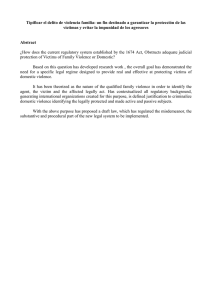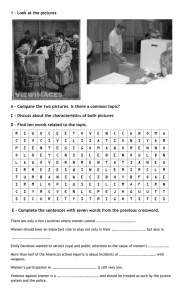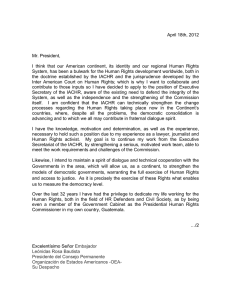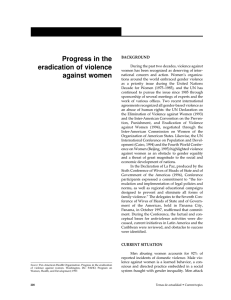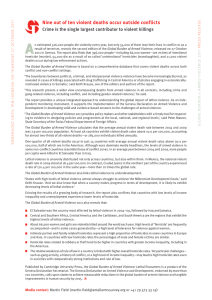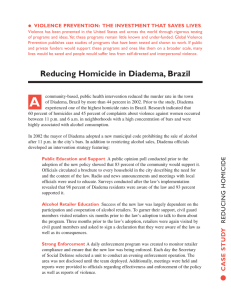04.LCI, Invisible, feminicidio.net, acvg, educative proyects
Anuncio
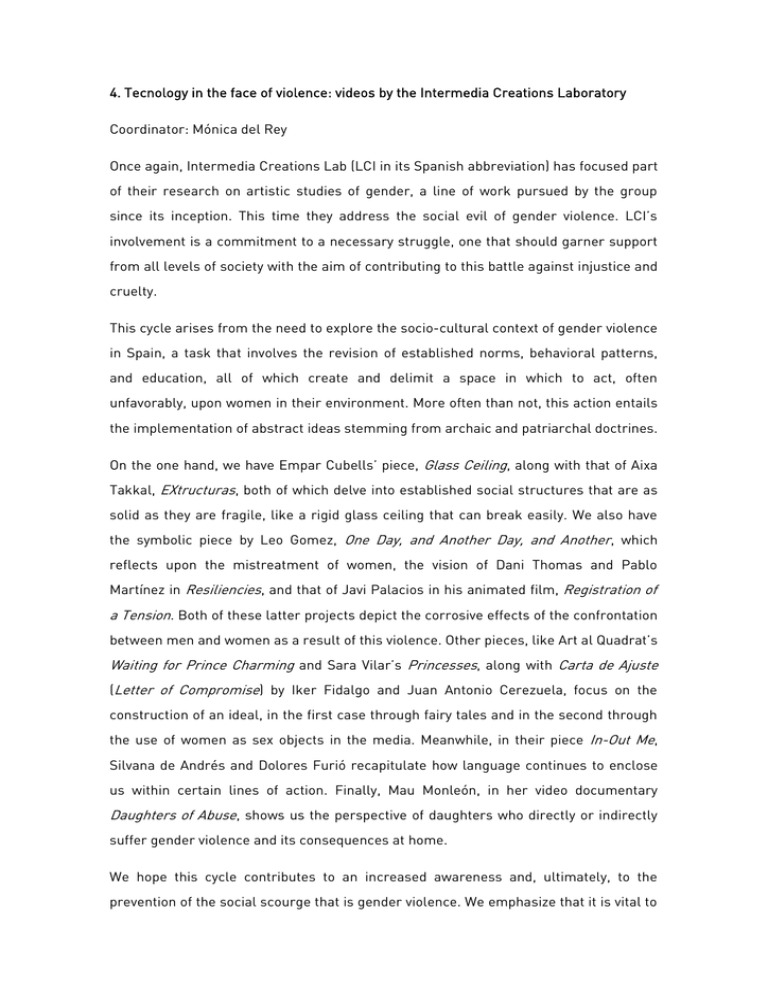
4. Tecnology in the face of violence: videos by the Intermedia Creations Laboratory Coordinator: Mónica del Rey Once again, Intermedia Creations Lab (LCI in its Spanish abbreviation) has focused part of their research on artistic studies of gender, a line of work pursued by the group since its inception. This time they address the social evil of gender violence. LCI’s involvement is a commitment to a necessary struggle, one that should garner support from all levels of society with the aim of contributing to this battle against injustice and cruelty. This cycle arises from the need to explore the socio-cultural context of gender violence in Spain, a task that involves the revision of established norms, behavioral patterns, and education, all of which create and delimit a space in which to act, often unfavorably, upon women in their environment. More often than not, this action entails the implementation of abstract ideas stemming from archaic and patriarchal doctrines. On the one hand, we have Empar Cubells’ piece, Glass Ceiling, along with that of Aixa Takkal, EXtructuras, both of which delve into established social structures that are as solid as they are fragile, like a rigid glass ceiling that can break easily. We also have the symbolic piece by Leo Gomez, One Day, and Another Day, and Another, which reflects upon the mistreatment of women, the vision of Dani Thomas and Pablo Martínez in Resiliencies, and that of Javi Palacios in his animated film, Registration of a Tension. Both of these latter projects depict the corrosive effects of the confrontation between men and women as a result of this violence. Other pieces, like Art al Quadrat’s Waiting for Prince Charming and Sara Vilar’s Princesses, along with Carta de Ajuste (Letter of Compromise) by Iker Fidalgo and Juan Antonio Cerezuela, focus on the construction of an ideal, in the first case through fairy tales and in the second through the use of women as sex objects in the media. Meanwhile, in their piece In-Out Me, Silvana de Andrés and Dolores Furió recapitulate how language continues to enclose us within certain lines of action. Finally, Mau Monleón, in her video documentary Daughters of Abuse, shows us the perspective of daughters who directly or indirectly suffer gender violence and its consequences at home. We hope this cycle contributes to an increased awareness and, ultimately, to the prevention of the social scourge that is gender violence. We emphasize that it is vital to include the visions and contributions not only of women, but also of men; we greatly appreciate and wish to highlight the involvement of our fellow artists Leo, Dani, Pablo, Javi, Iker, and Juan Antonio, comrades in arms, like so many others who contribute with sensitivity and perceptiveness to raise awareness of an issue that concerns us and involves everyone. SILVANA ANDRÉS & DOLORES FURIÓ In-Out Me, 2012 Digital video 2:30 min A silhouette of a woman appears on the screen and exhales a sigh into her hand. At times, a word arises from her sighs, fading after a few seconds. Other silhouettes appear and disappear from the scene, repeating the action. The words have different weights, tones, and consistencies. The sky seems to be stained with print fonts; the atmosphere surrounding the action is gradually modified. IKER FIDALGO & JUAN ANTONIO CEREZUELA Carta de Ajuste (Letter of Compromise), 2012 Digital video 2 min This video reflects upon the influence of the media in creating roles and stereotypes of women, as well as in the implicit violence - sometimes imperceptible - that results from the objectification of women and the constructs that media language creates with regard to them. ART AL QUADRAT (GEMA & MÓNICA DEL REY) Esperant el príncep blau (Waiting for Prince Charming), 2005 Digital video 3:07 min The world of abuse not only truncates physical lives but also sweeps away dreams and desires that every human being possesses: dignity, love, happiness, and peace. But reality awakens us from this dream that has been drilled into all of us, especially women, and which is repeated generation after generation. Waiting for Prince Charming is a fairy tale of disappointment that also forms part of a performance piece. EMPAR CUBELLS Glass Ceiling, 2012 Digital video 4 min. With Glass Ceiling, Empar Cubells brings us back to the need for recognizing the perpetuation of the limits imposed on women in postmodern society. The cage of domesticity has been replaced with that of institutions and new cathedrals of power. The glass ceiling, seemingly invisible, is the point of arrival on a journey through the career of the artist, who in turn reviews the evolution of this problem on a universal level. LEONARDO GÓMEZ Un día, y otro día, y otro (One Day, and Another Day, and Another), 2012 Digital video 3:39 min Through a simple analogy -- the image of a glass that fills drop by drop until it finally overflows -- the video entitled A Day and Another Day, and Another refers to the diffuse boundary that every battered woman must cross when she can no longer endure, when she decides to react, to break her silence, to ask for help, or go to the police to escape from abuse. This work invites us to reflect on where to set the limit, as well as on the consequences of doing so before or after the glass overflows. COLECTIVO GENÉRICO Daniel T. Marquina Pablo Martínez Resiliencias (Resiliencies), 2012 Video, Hd 3:22 min Resilience (psychology): "Resilience is the ability of an individual to generate biological, psychological, and social factors in order to resist, adapt, and become stronger in the face of risk, thereby generating individual social and moral success." Oscar Chapital C. (2011). Apply this to the pain and trauma of abuse, to its assimilation or to its being overcome, two ways to approach the same problem from the perspective of positive psychology. Apply this to the type of violence that goes against human nature, which damages and then regenerates the social cortex, creating both visible and invisible scars. MAO MONLEON Hijas del maltrato (Daughters of Abuse), 2012. Digital video 7:09 min This video focuses on the daughters of gender violence. Very few systematic studies have analyzed the impact of this violence on children living in these households, who generally share and experience situations of violence, directly or indirectly, with their mothers or the female figures that play the role of mothers in their lives. Filmed as a documentary, this video is part of a series of interviews with women between the ages of 19 and 30 who live in Spain. JAVIER PALACIOS Registro de una tensión (Registration of a Tension), 2012 Animated film (Loop with 13 frames). Video 3 min AIXA TAKKAL EXtructuras (StruXtures), 2012. Video, Hd. A formal and critical reconfiguration of domestic space. Concepts such as gender, violence and/or the media-driven formulation “gender violence” are configured in the social imagination from a simplified and sometimes closed reality. As representations, these concepts are built and sustained by dichotomies concerning ideas about what constitutes the cultural as opposed to the biological, the private sphere distinct from the public, that which ties one particular individual to society, the physical as separate from the mental, and other demarcations that subjugate and limit with impunity the reality in which they occur. A subtle and accepted form of violence, characteristic of any structure which, in its oscillation and movement, puts its own evolution at risk. SARA VILAR Princesas (Princesses), 2012. Video digital. 2 min. Once upon a time there was a beautiful princess who lived in a grand palace. Every day she cleaned her house; bought, washed, and ironed clothes; prepared food; and took care of her prince and their two children. She was a good mother who spent years and years hoping that one day her handsome prince would help her. 5. Invisible: video cycle coordinated by Gabriela Golder “I daresay that ‘Anonymous’, who wrote many poems without signing them, was often a woman.” Virginia Woolf “Women are not (judging by myself) naturally submissive, chaste, scented, and exquisitely dressed. Just a boring discipline granted these graces, without which they cannot know any of the enjoyments of life." Virginia Woolf. Orlando Tuesday May 22, 2012. I'm teaching at the School of Electronic Arts at the National University of Tres de Febrero, in the town of Caseros, in the province of Buenos Aires, Argentina. 8:00 pm. A person comes into the classroom and tells us about the memorial to be held that day, a month after the murder of the student Marisa Sotelo. We go down to the main hall, where students, teachers, authorities, friends, and parents have gathered, crying, talking and not being able to speak, trying to understand, demanding justice. Marisa was killed on a Sunday morning while she was doing overtime at the ceramics factory where she worked. Her murderer was a coworker. Her body was found in the well of the factory bath. Marisa was 25, studied, worked, and was beaten to death. The stories repeat themselves, changing the names, ages, places. Femicide is the killing of women, the result of gender violence exercised by a man on a woman, which occurs in both the private and the public sphere. .................. 11:00 pm the same day. I turn on the TV and zap the channels. Boobs and butts, pole dancing, cutting away skirts, and participants vying to seduce the program’s host, Marcelo Tinelli, on Showmatch, Canal 13, Argentina. I never watch Tinelli; I detest his show. But that day I stopped for a moment. Women like kittens, blowing little kisses, more asses, ultra tits, floss (the nickname for their tiny thongs), boobs again, which now casually escape from their bustiers. The showman touches them, laughs, and whispers things in the participants’ ears while they smile and believe in the possibility of "a better world." Women as sex objects. This program and its followers, emulators, and other friends and relatives are representatives of the violence produced and reproduced by the media. Gender violence, the symbolic violence. Instigators, promoters, exponents. The ratings for these shows reach an average of 30 points, some days reaching up to 40. This means that there are approximately 3,000,000 households watching it. Given that a typical household consists of four people, that would mean something like 12 million viewers. But it's not just the audience watching the TV; these programs promote opinions that one continues to find in society, opinions justifying violence against women or, in cases of rape, whether the victim provoked her assailant. .................. That day I stopped for a moment because I had just arrived home from the university where we had had a memorial for a fellow student who had been murdered, a victim of femicide, only a month before. The pieces that make up this exhibit deal with the denunciation of gender violence, the fight against this violence, resistance, identity, and memory. Secrets, silence, invisibility, inability to talk about certain things. These pieces are acts of revelation. ANA GALLARDO A boca de jarro (Point Blank), 2008 Silvia Mónica, 58 years old Video 6:51 min Sylvia Monica is a transvestite and an activist in Ammar Capital, an organization of women of various ages and life experiences. They work as prostitutes. They think of themselves as sex workers, but did not choose prostitution as a way of life. Rather, they came to this work by forces beyond their control. Silvia Monica always wanted to be a singer. In this project, a journal that deals especially with the issue of child prostitution invited her to perform a song. GUSTAVO GALUPPO Cinco putas en febrero (Five Prostitutes in February), 2012 Documentary 18 min Movies, TV, and popular songs constitute a framework for the inevitable slide into violence. And in the middle of it all, the persistent cry of a prostitute as the only sign of strength and resistance in the midst of this barbarism. GABRIELA LARRAÑAGA, GRACIELA TAQUINI, & TERESA PUPPO Secretos (Secrets), 2007 Video 5:20 min In front of their home, three women from different generations share, hide, and exchange repressed family secrets. PRICILLA MONGE Lección de Maquillaje (Make-up Lesson), 1998 Video 3:45 min A man applies make-up to a woman. We wait for the final result – the end “look” – and then we realize that he has made her up to look as if she had been beaten. This is Monge’s critique of gender violence and the gender roles that make this type of abuse possible. BETH MOYSÉS Diluidas en Agua – Zaragoza (Diluted in Water – Saragossa), 2008 Video 5:37 min Forty women participated in this performance: twenty of them were living in the shelter at the time and the other twenty are women who hope to change the violence present in women's lives. The white dresses were made by the women in the shelter. Each of the participants received a dress and a red pen. On the inside of the white dress, they wrote everything that had happened in their lives, all the suffering they experienced. The dress became a large white page, like that of a diary. Later, in basins full of water, they washed the clothes, trying to remove the marks, the memories, the pain of the other women who remained in their dresses, trying to whiten them. The content of the words remained in the basins, diluted in water. Reconstruyendo Sueños – Montevideo (Rebuilding Dreams – Montevideo), 2007 Video 5:28 min Uruguay, 2005. One hundred women in bridal dresses walk down the streets of Montevideo wearing transparent white gloves to symbolize their own skin. Because they are transparent, the women embroidered them, copying the lines of their hands, recalling the pain they have suffered throughout life. When the gloves were removed it felt as if the wound was already healed, as if they had shed their old skins to be reborn into a new life. Ex-purgo (Ex-purgate), 2011 Video 3:12 min The hand of the artist has a hive-wound. The hand slowly bleeds honey, as if it had become a house of bees, a social hive in which the bees are represented by women working within a group to change society. The hurt, the pain experienced by the artist, becomes positive: changing blood into honey. It's as if everything that had happened in her life had been transformed into something that would change other women’s lives. DIANA SCHUFER Yo te creé, yo te destruyo (I Created You, I Will Destroy You), 2011 Video 4:30 min A drawing depicting a human figure with indicators of sexual abuse. A hand penetrates the drawing, alluding to the abuse and representing the actions of the abuser and the abused. The tension and the sound of the pencil on the paper, together with the movement of the finger, bring us face to face with the morbid thrill produced by transgressing the maximum taboo of humanity: incest. GRACIELA TAQUINI Granada, 2005 Video. Protagonist: Andrea Fasani 6 min Based on the testimony of the artist Andrea Fasani, victim of the state terror that prevailed in Argentina during the 1970s. Her aesthetic is based on facial close-ups and baroque staging. She explores the selectivity of memory and the interstices between remembering and forgetting. LYSETTE YOSELEVITZ Cicatrices (Scars), 2011 Video 6:15 min A personal approach to the pain of mourning, this piece gives us access to an intimate performance. The words written on the skin come from a poem written in response to events that occurred, events related to a sense of loss. The traces of ink on the skin evoke a sense of melancholy and human frailty. Feminicidio.net: posters by Graciela Atencio and Francisco Gatica Las cifras de la barbarie (The Statistics of Barbarism), 2010 Digital art A4 and A3 Most Latin American countries have no official statistics on feminicide, although there are thousands of sexist crimes committed each year in the region. In many cases, the data available has been compiled by women's non-governmental organizations. In this campaign, "The Statistics of Barbarism," we decided to represent the phenomenon of feminicide by displaying the total number of women murdered with the official flowers of each country. Our creativity comes directly from our rules regarding style and publication: we do not show or display explicit images of violence. We play with the juxtaposition of elements to put a veil on gender violence in order to avoid revictimizing the women who have suffered from abuse. ACVG: The web platform artecontraviolenciadegenero.org ACVG: www.artecontraviolenciadegenero.org is a civic, activist web platform against gender violence made up of feminist and interdisciplinary artists, researchers, educators, and citizens. ACVG was set up to make gender violence more visible and to support the strategic fight against this social evil through art and technology, combining social activism and political struggle. Its many activities include organizing exhibitions, publishing articles, organizing public events, data observation, and active struggle through strategies developed within the context of mainstream educational activities. The platform was started in Valencia, Spain, and is open to national and international users. It was developed thanks to a research project begun in 2009 that promoted the use of new technologies to advance and improve the situation of women with regard to gender violence. The platform responds to a major flaw in both the research and teaching of art in relation to gender studies, specifically the limited amount of current information on the artistic endeavors of women and men who are working against gender violence in the technological milieu. The specific objectives of the ACVG platform are to create and publicize a virtual gallery that brings together the experiences of artists and theorists working with new technologies to explore and enhance the intersections between art and violence. We also wish to implement the function of the web platform through university research, thus creating a network where women and men can share art-related information, ideas and projects in order to promote equality of opportunity and social equality. We also wish to develop online publications about the new technologies, along with posting studies of gender and violence. We want to generate participatory experiences to educate users in gender equality, using virtual forums to assess the effects of exposure, and to create networks and participatory movements, joining forces with other platforms and social entities. At the same time, we want to unify, strengthen, and implement initiatives, both at the national and international level, committed to the fight against gender violence. The ACVG platform needs your participation; we thus call on you to contribute to the platform with all manner of collaborations, projects, ideas, and research in your respective sphere of action. MAINSTREAMING: EDUCATIONAL PROJECTS Coordinated by Emilia Quiñones Otal and Mau Monleón Pradas In both Latin America and Spain, gender violence represents a social evil that calls for preventive measures. Laws that criminalize abuse against women due to their gender focus mainly on which actions should be charged and what kind of convictions should be handed down after a crime has already been committed. Such laws define criminal acts and the penalties for them in order to punish the abuser and/or murderer, as the case may be. We believe that state-sponsored work on gender must also focus on prevention and that this should be the most important project with regard to our investment in the future of new generations of children, youth, and adolescents. Naturally, it matters what type of sanctions and sentences can be imposed by law on a person who has abused or murdered a woman, and in Spain the passing of the Organic Law of Comprehensive Protection Measures Against Gender Violence in 2004 meant an improvement (although it came a bit late considering that Puerto Rico’s Law 54 for the Prevention of and Intervention in Domestic Violence has been on the books since 1989) in making visible, classifying, and, to some extent, preventing such violence. We think, however, that patriarchal codes continue to structure the way women and men are educated from birth, not only through the institutions of the family, schools, and universities, but what is especially dangerous, through the manipulation of the mass media, including television and the internet. For this reason, an exhibition like this one, where the work proposed by the artists is aimed at raising awareness and making a commitment against gender violence, must necessarily contain a didactic component. We have thus decided to expand the aesthetic and activist nature of this exhibition to include the field of education, creating a special section of documentary material prepared by various groups, associations, and organizations against gender violence in Latin America and Spain. Ultimately, we wish to create a documentation center for educational projects, catalogs, and bibliographies on this topic. The main goal is to situate the public within a context of gender violence prevention as well as to raise awareness of and overcome inequalities between men and women with regard to symbolic, structural, and physical gender violence. To this end we will include catalogs along with teaching and research publications and educational videos and texts as part of a “documentation center” within the exhibition. Below we have selected several images from these publications which have been included in the bibliography and are shown in their entirety in the “Educational Projects” section of our website: www.artecontraviolenciadegenero.org.
